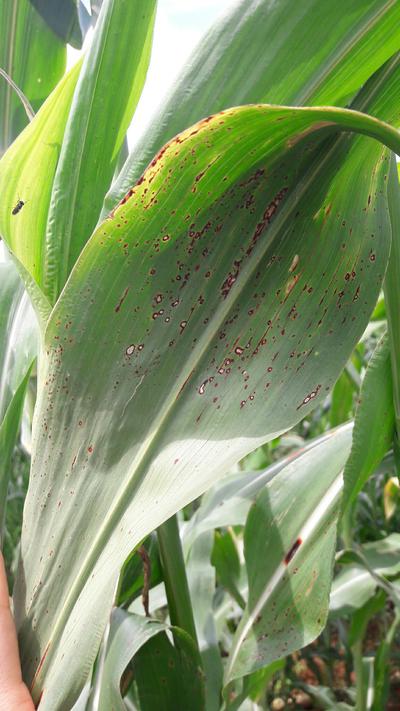Anthracnose Leaf Blight and Stalk Rot
Colletotrichum graminicola
Fungus
In a Nutshell
- Small, oval, water-soaked lesions on leaves.
- Spots with brown centers and purplish margins.
- Patches of blight cover the whole leaf.
- Top dieback.
- Stalk rot.
Can also be found in
Symptoms
Plant type, environmental conditions and pathogen strength determine the outcome of the infection. On susceptible varieties, the infection is characterized by three distinct phases: leaf blight, top dieback, and stalk rot. Small, oval, water-soaked lesions appear first on lower leaves, near leaf tip or mid rib, and later on the upper ones. They develop into translucent spots with tan centers and purplish margins and can coalesce to form patches of blight that cover the whole leaf (leaf blight). At later stages of plant growth, dark, raised specks appear on dead tissue if the conditions are favorable. Injuries to stalks and stems favor the colonization of internal tissues which leads to other symptoms such as top dieback and stalk rot.
Recommendations

Organic Control
We don't know of any effective treatment against Colletotrichum graminicola. Please get in touch with us in case you know of anything that might help to fight this disease. Looking forward to hearing from you.

Chemical Control
Always consider an integrated approach with preventive measures together with biological treatments if available. To date, there are no effective fungicides available.
What caused it?
The fungus survives in plant residues in the soil, from where it is distributed onto the lower leaves by wind and splashing rain during spring. The lesions that develop on leaf blades cause secondary spreading to upper foliage or stalks. Stalk injury increases the likelihood of the colonization of internal tissues. If environmental conditions are propitious other symptoms such as top dieback and stalk rot appear consequently. The life cycle of the fungus (and disease) is favored by relatively warm temperatures (20 to 30°C), high relative humidity for a prolonged period, and frequent rainfall. The fungus can infect plants at the seedling stage but it rarely causes substantial yield loss if the fields are suitably fertilized. Rapidly expanding leaves are less prone to developing symptoms.
Preventive Measures
- Plant resistant varieties if available in your market.
- Plan a long-term crop rotation with non-host crops (non-grass crops or soybean).
- Monitor the fields for the presence of symptoms, for example stalk rot.
- Maintain balanced soil fertility and stable pH-levels.
- Provide the fields with good drainage.
- Control weeds in and around the fields.
- Plow deep after harvest and bury residues.



